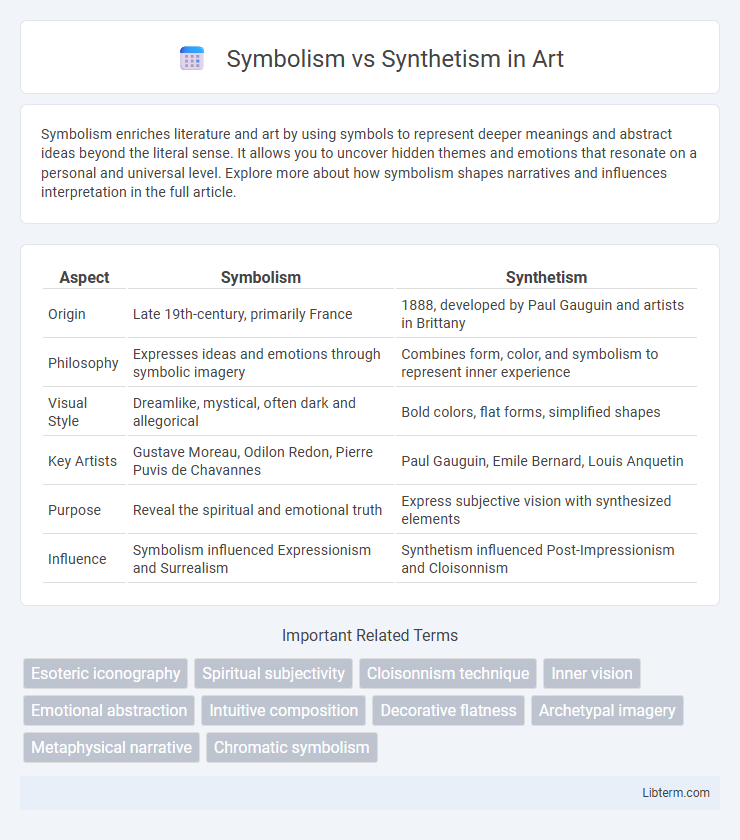Symbolism enriches literature and art by using symbols to represent deeper meanings and abstract ideas beyond the literal sense. It allows you to uncover hidden themes and emotions that resonate on a personal and universal level. Explore more about how symbolism shapes narratives and influences interpretation in the full article.
Table of Comparison
| Aspect | Symbolism | Synthetism |
|---|---|---|
| Origin | Late 19th-century, primarily France | 1888, developed by Paul Gauguin and artists in Brittany |
| Philosophy | Expresses ideas and emotions through symbolic imagery | Combines form, color, and symbolism to represent inner experience |
| Visual Style | Dreamlike, mystical, often dark and allegorical | Bold colors, flat forms, simplified shapes |
| Key Artists | Gustave Moreau, Odilon Redon, Pierre Puvis de Chavannes | Paul Gauguin, Emile Bernard, Louis Anquetin |
| Purpose | Reveal the spiritual and emotional truth | Express subjective vision with synthesized elements |
| Influence | Symbolism influenced Expressionism and Surrealism | Synthetism influenced Post-Impressionism and Cloisonnism |
Introduction to Symbolism and Synthetism
Symbolism emerged in the late 19th century as an artistic movement emphasizing the representation of ideas and emotions through symbolic imagery rather than direct depiction. Synthetism, pioneered by artists like Paul Gauguin, combined elements of Impressionism and Symbolism by synthesizing subject matter with bold colors and simplified forms to convey deeper meaning. Both movements influenced modern art by challenging traditional representation and prioritizing subjective experience in visual expression.
Historical Origins of Symbolism
Symbolism originated in the late 19th century as a reaction against the naturalism and realism dominating art and literature, emphasizing the representation of ideas and emotions through symbolic imagery and metaphor. Rooted in French literature and influenced by poets like Charles Baudelaire and Stephane Mallarme, Symbolism sought to express the ineffable and abstract, often exploring themes of mysticism and the subconscious. This movement laid the foundational groundwork for later developments in modern art and inspired the Synthetism approach, which integrated Symbolist ideals with vivid color and simplified forms in painting.
The Emergence of Synthetism
The emergence of Synthetism marked a shift from the introspective and dream-like qualities of Symbolism toward a style emphasizing bold colors, simplified forms, and the synthesis of subject and idea, prominently led by artists like Paul Gauguin and Emile Bernard. This movement prioritized the emotional resonance of colors and shapes over the detailed representation of reality, blending influences from Japanese prints and folk art to create a new visual language. Synthetism notably contributed to the development of modern art by fostering a more abstract and expressive approach that influenced Post-Impressionism and early Cubism.
Key Philosophies: Symbolism vs Synthetism
Symbolism centers on expressing ideas and emotions through metaphorical imagery and abstraction, emphasizing the inner experience over realistic representation. Synthetism combines naturalistic depiction with symbolic colors and simplified forms, aiming to synthesize subject, idea, and color into a harmonious whole. Symbolism prioritizes mystical and emotional depth, whereas Synthetism focuses on formal structure and the integration of multiple artistic elements.
Major Artists and Influences
Symbolism, championed by artists like Gustave Moreau and Odilon Redon, emphasized dreams and mystical themes, influencing the literary world and later Surrealism. Synthetism, developed by Paul Gauguin and Emile Bernard, focused on bold colors, flat forms, and the synthesis of subject matter with the artist's feelings, directly impacting Post-Impressionism and the development of Primitivism. Both movements reacted against naturalism, prioritizing internal vision over realistic representation, shaping modern art's evolution in the late 19th century.
Visual Characteristics and Techniques
Symbolism emphasizes evocative imagery, mystical themes, and the use of color to represent emotions and ideas beyond literal representation, often employing dream-like, ethereal visuals. Synthetism integrates flat areas of bold color, simplified forms, and strong outlines, influenced by Japanese prints, aiming to synthesize subject, form, and color into a harmonious whole. Techniques in Symbolism favor subtle gradations and textured brushwork to evoke mood, whereas Synthetism uses clear contours and uniform color fields to achieve decorative clarity.
Subject Matter and Themes
Symbolism emphasizes exploring spiritual, mystical, and emotional themes through dreamlike and often abstract imagery, aiming to evoke deeper meanings beyond the visible world. Synthetism focuses on synthesizing form, color, and line to depict everyday subjects, often incorporating flat areas of bold colors and simplified shapes that express the artist's personal interpretation. While Symbolism delves into mythology, fantasy, and metaphysical ideas, Synthetism highlights intimate scenes and nature with an emphasis on decorative harmony and subjective perception.
Symbolism and Synthetism in Literature and Art
Symbolism in literature and art emphasizes the use of symbols to represent ideas and emotions, often delving into the mysterious and spiritual aspects of existence. Synthetism, emerging from post-Impressionism, combines synthesized forms and colors to express inner emotions and meanings rather than realistic depictions. Both movements prioritize subjective interpretation, but Symbolism leans towards evoking moods and psychological states, while Synthetism focuses on simplified shapes and vibrant palettes to convey symbolic content.
Impact on Modernism
Symbolism's emphasis on expressing inner emotions and ideas through metaphorical imagery profoundly influenced Modernism's exploration of subjective experience and abstract representation. Synthetism, characterized by flat planes of color and strong outlines pioneered by artists like Gauguin, contributed to Modernism's break from realistic depiction towards stylistic experimentation. Both movements challenged traditional artistic norms, paving the way for Modernist innovations in literature, visual arts, and philosophy.
Lasting Legacy and Contemporary Relevance
Symbolism emphasized the expression of mystical and emotional experiences through metaphor and allegory, influencing modern art and literature by inspiring introspective and abstract approaches. Synthetism, characterized by its flat planes and bold outlines, profoundly impacted Post-Impressionism and the development of modernist aesthetics, paving the way for movements like Fauvism and Cubism. Both movements maintain contemporary relevance by shaping narrative strategies and visual styles in art, underscoring the continued exploration of subjective perception and innovative form.
Symbolism Infographic

 libterm.com
libterm.com